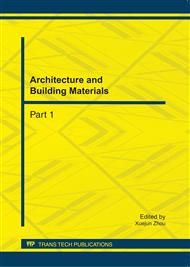p.972
p.977
p.982
p.988
p.994
p.1000
p.1005
p.1014
p.1018
Behavior of HSC with Polypropylene Fibers after Exposure to High Temperatures
Abstract:
An experimental research was performed on the compressive strength and splitting tensile strength for HSC with various polypropylene(PP) fibers after exposure to temperatures 300°C, 500°C, 700°C, 900°C. Cubes of 150mm×150mm were designed and fabricated with C60, blended with silica fume and slag, mixed with PP fibers, respectively. These specimens were naturally cooled to room temperature after being heated in an electric furnace. No explosive spalling was observed during the fire test on all HSC with PP fibers. From the results of nine types of concretes, both the compressive strength and splitting tensile strength of HSC with PP fibers decreased with the increase of temperature. Through a series of measurement, the relationships between the mechanical properties and the various PP fibers in HSC were analyzed, including the dosage and length of PP fiber. Based on the comparison in the experimental results, the proposed optimum of PP fiber in HSC was 1.5kg/m3 under the test condition. In addition, PP fiber with the length of 8mm could be more applicable to use.
Info:
Periodical:
Pages:
994-999
Citation:
Online since:
September 2011
Authors:
Price:
Сopyright:
© 2011 Trans Tech Publications Ltd. All Rights Reserved
Share:
Citation:


